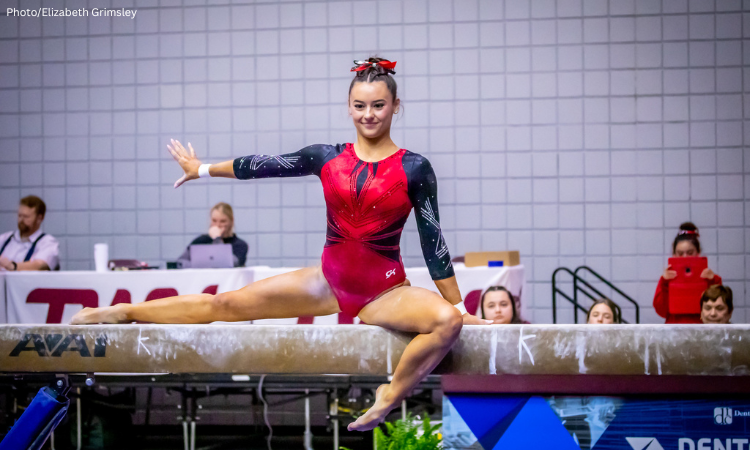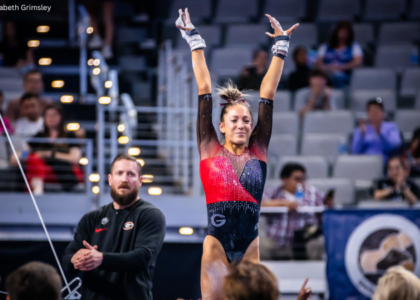The strategies that play into building a strong and balanced lineup vary widely from school to school. While this ushers in some excitement, it often leaves gym fans wondering what factors play into a coach’s decision to rest or not rest, compete or not compete, a certain gymnast. More so, does playing around with lineups and using depth affect how a team performs? Is consistency the best strategy to win, or does resting gymnasts and trying out new routines benefit performance? To examine this, our data team took a look at lineup consistency through a statistical lens to determine if consistency in lineups makes a significant impact on a team’s success.
Methodology
Inspired by FiveThirtyEight’s consistency calculations for Premier League teams, we first pulled individual results for all of 2023 from Road to Nationals. Then, for each gymnast, we found how many events they competed each week and how that changed from the previous week. For example, if a gymnast competed in the all-around one week, but then only competed on vault and floor the next, that is a total change of two events. The individual changes were then summed for all gymnasts on a team to find the total lineup changes per team over the entire season.
Next, we calculated how many meets each team competed in over the entire 2023 season – including postseason – and how many event spots there were for each team by multiplying the total number of meets by four events, and then by six gymnasts per event. For example, at 16 meets each, LSU, Oklahoma, and Towson competed the most, so they had a total of 384 possible lineup spots over the entire season.
Our Lineup Consistency Score (LCS) was calculated by comparing the total lineup changes to the total number of event spots per team. A higher LCS indicates fewer lineup changes week to week. A maximum score of 100% means that over the entire season, a team never changed the number of events in which each individual gymnast competed.
Lineup Consistency Score Compared to Final Team Rank
The resulting LCS range from N.C. State at 98.9% to Greenville at 83.3%. The average score across all teams is 90.5%, so on average, only about 10% of a team’s lineup changed over the 2023 season.
N.C. State’s high LCS is driven by its dependence on event specialists as well as its reliable two- and three-event gymnasts. Eight of the 20 gymnasts on N.C. State’s roster in 2023 appeared in lineups every single week, while six never did. Emily Shepard competed in the all-around for each meet of the season, with Alexis Ortega joining her in the all-around for the second half of the season.
Of the top teams, Florida and Michigan had notably lower LCS. For Florida, dependable all-arounder Trinity Thomas was rested on various events throughout the season and then had a devastating injury during regionals that left her competing on only a couple of events in the rest of the postseason. Florida had a lot of depth in its roster and played around with several different lineups across all four events, propelling them to a second-place finish overall. Michigan also used its depth to its advantage, allowing some of its strongest athletes – like Natalie Wojcik and Gabby Wilson – to switch between competing in the all-around and sticking with three events. It also took advantage of the versatility on its roster using several one- and two-event specialists for lineups throughout the season.
The trend line indicates a negative relationship between a team’s final ranking and its LCS. In other words, higher-ranked teams at the end of the 2023 season tended to have fewer lineup changes than teams who finished lower in the rankings. While it is typically assumed that stronger teams have greater depth within their lineups, the results show that these teams’ coaches tend to rely on the same gymnasts week to week.
While this relationship is statistically significant at p < 0.001 level, meaning there is a less than 0.1% chance this trend is due to chance, there is a lot of variation in LCS across all teams, as seen by how spread out the teams are. While on average a lower-ranked team has greater lineup differences week to week, there are also high-ranked teams that saw comparatively high variability. For example, Denver had the second-lowest LCS at 83.9% but finished the season at 13 overall.
Lineup Consistency Score Compared to Final Team Rank by Event
One of the downsides of the LCS is that it doesn’t differentiate by event. If a gymnast competes on vault and uneven bars one week and then on beam and floor the next, this is not counted as a lineup change because the gymnast competed on two events at each meet.
To remedy this and see what the LCS looks like at the event level, we recalculated this score for each event. For example, if a gymnast competed on vault one week, but not the next, or vice versa, that’s a change of one. We then reproduced the LCS for each event by comparing the total number of changes per team by event to the total number of potential lineup spots on that event over the entire season.
Several teams did not change which gymnasts competed on each event during the 2024 season. Seven teams kept the same uneven bars lineup all season, six kept their beam lineup, and one team each kept its vault and floor lineup. The highest-ranked team that kept its event lineup the same all season was Oregon State, who finished fourth on beam.
The overall trend lines also reveal some interesting relationships. The uneven bars trend line is very close to the overall rank trend line, while vault and beam are nearly twice as steep. Beam had the greatest overall relationship between LCS and final team rank on that event, indicating that stronger teams relied more heavily on a core group of beam workers all season compared to less strong teams.
Floor is the only event with a positive relationship between the LCS and the final event ranking, but this was very small. Further, the relationships for uneven bars and floor were the only two that were not statistically significant, meaning that these relationships may be due to chance rather than a meaningful relationship in the data.
After examining the data both on a team and event level, the numbers show that a consistent lineup does positively impact a team’s success. While powerhouses like Florida and Michigan can get away with testing their depth, these teams are also known for their star-studded and consistent lineups, especially during the final weeks of the season. For both teams and individual events, having consistency in lineups positively impacts rankings. Of the events, beam stands out as one where consistency is key in lineups, evidenced by Oregon State, a team that has mastered the art of the consistent lineup, resulting in a No. 4 ranking on the event. While some teams are plagued by injury and cannot afford to keep a consistent lineup, the data shows there is nothing to lose by sticking with what, or who, you know.
READ THIS NEXT: Data Deep Dive: When Do Gymnasts Peak?
Article by Bailey Sutton and Emma Hammerstrom





Super interesting piece–I’ve been wondering about this for a while. Two things I wonder:
1. Do we see the same patterns in prior years?
2. Does the number of newcomers to the team have any impact on lineup consistency scores?